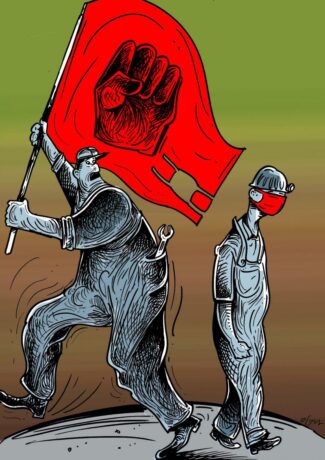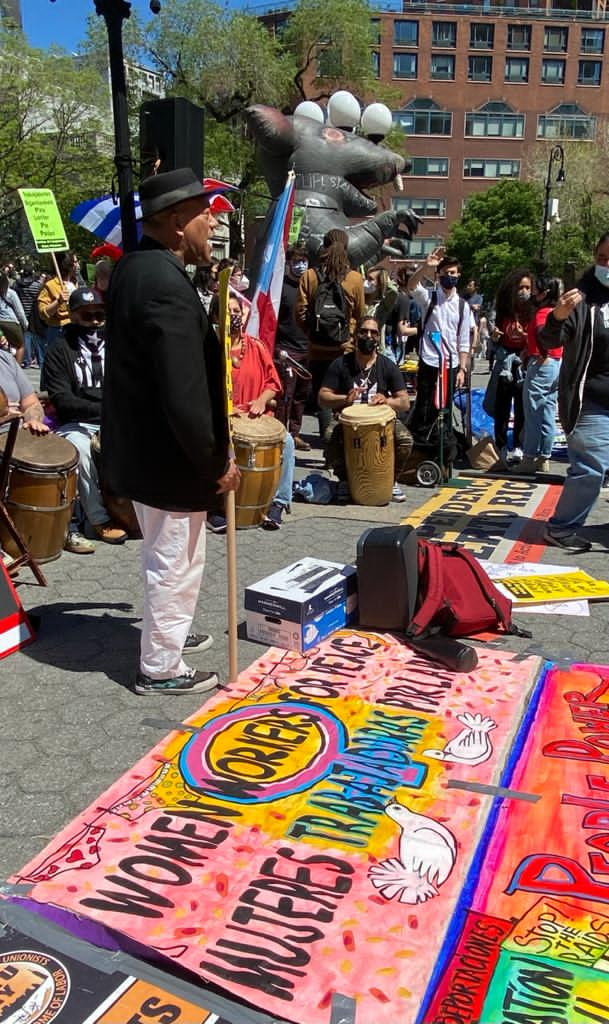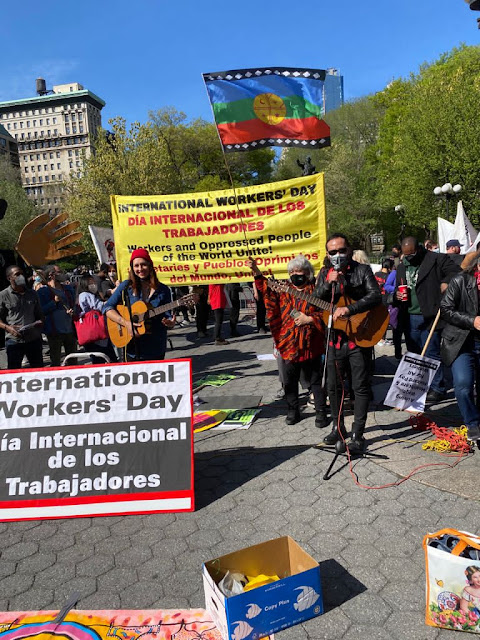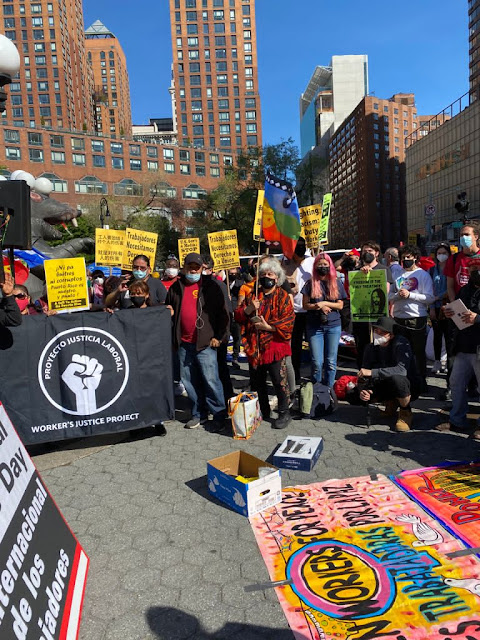Colombia: En alerta roja. Piden apoyo internacional.
|
-
Perú. Plan “Rescate 2021” fujimorista: Más de lo mismo
Alejandro Narváez Liceras* / Resumen Latinoamericano 3 de mayo de 2021 El Programa de Gobierno fujimorista llamado “Plan de Rescate 2021 y Reconstrucción Nacional”, revela principalmente...
-
Perú. ¿A quiénes respondería Keiko Fujimori de llegar al poder?
Resumen Latinoamericano, 3 de mayo de 2021 Diseño: Fabrizio Oviedo/ La República Si Keiko Fujimori llegara a ser presidenta, ¿a quiénes respondería? Los aportes millonarios...
-
Perú. EsSalud: Hospitales convocan paro nacional el 27 de mayo por falta de oxígeno y camas UCI
Resumen Latinoamericano, 3 de mayo de 2021 El Sindicato Nacional Médico del Seguro Social del Perú (Sinamssop) ha convocado a un paro nacional de 24...
 El
2 de mayo de 1997 fallecía Paulo Freire, pedagogo de los oprimidos y
transmisor de la pedagogía de la esperanza. Entrevista de 1985...,
El
2 de mayo de 1997 fallecía Paulo Freire, pedagogo de los oprimidos y
transmisor de la pedagogía de la esperanza. Entrevista de 1985..., |
| 4 acciones de la Administración Biden para reunificar a familias separadas en la era de Trump |
| El Departamento de Seguridad Nacional arranca esta semana el plan con el Grupo de Trabajo para reunir a niños con sus padres |
| Leer más>> |
Es un dia apropiado para decir algunas verdades y desmontar las Mentiras de los responsables de la Crisis de la mal llamada PANDEMIA el rostro de la Larga Crisis en que nos tiene sumido el Capitalismo Salvaje.Solo en EE.UU. 600 mil HAN MUERTO por la Pandemia.Un Genocidio cometido por la vieja clase politica y los Ladrones de las Grandes Corporaciones,Los Chupa Sangre del Wall Street,el Fondo Monetario Internacional y todas las instituciones que a nivel internacional operan pagados por el poder imperialista.Esta es una Primera verdad que debemos decir a los cuatro vientos.
Una segunda gran mentira capitalista e imperialista es la Dramatica situacion de la Inmigracion Mundial.Son los Imperialistas y capitalistas los Unicos Culpables de estas Nuevas Oleadas de la Inmigracion.La causa son las Guerras Falsas de Irak,Libia,Asfaganistan y demas Paises del Medio Oriente,Asia y Africa.Millones de seres humanos ya no viven en sus Paises de Origenes.
En America Latina son los mismos Criminales,Invasores y Golpistas Los Imperialistas y Capitalistas,que dieron un Golpe militar en Honduras,Tumbaron gobiernos en El Salvador,Guatemala,en Paraguay,Ecuador,Bolivia,Peru,Chile,Brasil,Argentina en estos pais con distintos disfraces gobiernan y hacen y desacen con los gobrenantes lambebotas.En Colombia han impuestos Siete Bases Militares desde las cuales dia y noche planea La Invasion contra Venezuela,Cuba y otros Paises.Estos Satrapas Capitalistas e Imperialistas son los Unicos responsable de la Inmigracion Centroamericana,Mexicana y de la que hace mas de una decada vive en los EE.UU.
SI EN EL 2006 HERAMOS 12 MILLONES LOS INDOCUMENTADOS EN ESTE PAIS HOY SOMOS ALREDEDOR DE 30 MILLONES.EL SILENCIO COMPLICE CON ESTA VERDA QUE GUERDA LA CLASE POLITICA Y LA PRENSA MERCENARIA ES DESCARADA.SOLO NOSOTR@S PODEMOS CAMBIAR LAS COSAS Y CONQUISTAR TODOS NUESTROS DERECHOS.PORQUE VAMOS A ESTAR CLARO QUE NINGUN SER HUMANO ES ILEGAL.
SALIR DE LA OSCURIDAD.
TOMAR LAS CALLES,
EXIGIR ASILO Y LEGALIZACION AHORA PARA TOD@S.
A CONSTRUIR SINDICATOS Y PODER POPULAR COMUNITARIO POR TODOS LOS RINCONES DEL PAIS.
VIVA EL 1 DE MAYO 2021.
UNID@S VENCEREMOS.
NO CONFIAR EN REPUBLICANOS NI DEMOCRATAS.
SOLO LA LUCHA PROLETARIA NOS HARA LIBRES.
Intervencion de Victor Toro en la Plaza Union Square el 1 de mayo 2021.
Asunto: ¿Por qué la muerte de latinos por abuso policiaco no ha generado protestas a nivel nacional? (podcast) | El Diario NY.
|
 RadioCENTENARIO
@Centenario1250.
RadioCENTENARIO
@Centenario1250.
James Petras
analizó los primeros 100 días de gobierno de Joe Biden con un balance
negativo. Dijo que tiene una política muy agresiva con Rusia y China,
las relaciones con Irán no marchan bien y tampoco tiene relaciones
positivas con América Latina.  https://archive.org/details/2021-04-26-james-petras …
https://archive.org/details/2021-04-26-james-petras …
Dosier Wolfgang Harich x Contra el diluvio.El
filósofo alemán Wolfgang Harich sería uno de los mayores y mejores
representantes de cierto giro ecológico en la tradición socialista...,
Entrelazar
un movimiento nacional con un movimiento social es el primer instante
del proceso que ha conducido a la Revolución cubana en su estructura
actual...,
3 DE MAYO 2021.
Mundo.
Cuando el diablo mete la cola: Gramsci en América Latina x Florencia Oroz.
 Qué
Gramsci leyeron los comunistas argentinos, se pregunta Aricó. Tal
interrogante no aplica: la aceptación de las teorías del sardo estuvo
supeditada a su desconocimiento...,03/05/2021 :: Cuba,
Qué
Gramsci leyeron los comunistas argentinos, se pregunta Aricó. Tal
interrogante no aplica: la aceptación de las teorías del sardo estuvo
supeditada a su desconocimiento...,03/05/2021 :: Cuba, De amansados no se hacen revolucionarios x Alfredo Guevara.

Shocking accounts from ICE detainees, local political corruption and the fight against it.
On March 6, 2020, Marcial Morales was sent to the Essex County Jail in Newark, New Jersey to await deportation proceedings. For the 37-year-old pizzeria manager and father of three children, it was the beginning of a nine-month ordeal in the pits of the U.S. immigrant detention system. For the local jails that contract with the federal Bureau of Immigration and Customs Enforcement (ICE) to hold detainees like Morales, it was money in the bank — $110–$120 per night, or roughly $30,000 before he was released in November.
“To make money, they keep the detainees in there, hoping they will be so dismayed that they give up and go back to their birth country,” says Morales, who journeyed alone to the United States from Guatemala when he was 15 years old.
On any given night, the jails in Bergen, Essex and Hudson counties combine to hold hundreds of immigrant detainees from New York and New Jersey and are capable of holding many more. Their law libraries have no legal books, their water is hardly potable and detainees are very rarely allowed to breathe fresh air. The Bergen County Jail in Hackensack is overrun with rats and mosquitoes, Morales says, while at Essex, guards routinely administer violent beatings and guard-on-prisoner rape is not uncommon. At Hudson, militarized law enforcement is called upon instead of medical staff to deal with health emergencies.

When a detainee at the Hudson County Jail in Kearny suffered an epileptic seizure, he had to wait 15– 20 minutes before a single nurse came to his aid, said ex-detainee Bryan Vergara. “He was there on the floor with his head thrashing, blood everywhere,” Vergara said. “The first people to arrive are police, like a SWAT team just for the jail. They cuffed his legs and hands and let him continue to convulse on the floor.”
For the Democratic Party leaders who control Essex and Hudson counties and the Democratic sheriff who presides over Bergen County’s corrections spending, though, immigrant detention is a lucrative business that pads their annual budgets with millions of dollars in extra revenues (See sidebar). Their story is also a cautionary tale of how the stark partisan divide over immigration in the Trump era will become blurrier in the Biden era.
At the same time, support for immigrant rights intensified on the left during the Trump years and is fueling the opposition to the cozy arrangements that have filled the coffers of the three North Jersey counties for years. Hunger strikes by detainees have galvanized protests on the outside while advocates are insisting immigrants should be treated humanely no matter which party is in charge.
“We need to stop using immigration detention. It’s never good for anyone. It costs [federal] money, it hurts people. They come out different — whether they’ve been in there three months or three years, they experience dramatic psychological trauma,” says Chia-Chia Wang, organizing and advocacy director at the American Friends Service Committee’s Immigrant Rights Program.
“My lawyer said, ‘You’ll go home. I took the plea deal, and then they sent me to ICE.”
Whether a person is undocumented or is a non-citizen but has a visa, they can be immediately deportable for having committed even some misdemeanors. Since New Jersey’s adoption of the Immigrant Trust Directive in November 2018, law enforcement is not supposed to work in collaboration with immigration officials but that doesn’t stop ICE from receiving a records notice every time a non-citizen is released from incarceration. And according to TRAC Immigration, a project by Syracuse University, most people in detention don’t even have criminal record.
“The most generous justification of ICE detention is to make sure that people show up to court but detention in general is actually harmful to due process,” says Anna Byers, an immigration lawyer with American Friends Service Committee. “The more that numbers come out about people showing up to court, the clearer it is that detention is in no way necessary for people to show up to court,” she says. “A lot of people are unwilling to fight their cases if they have to be detained during their process. Some people choose to just be deported to be able to send money from their home country.”
A Wave of Hunger Strikes
Morales found himself in ICE detention at the Essex County Jail when he took a plea deal after having served 21 months in the Warren County Jail awaiting a trial that resulted in a hung jury.
“My lawyer said, ‘You’ll go home. You’ll go back to see your kids’ and all of that. So I took the plea deal, and then they sent me to ICE.”
After being held in Essex County for nearly eight months, Morales was transferred to the Bergen County Jail, along with 60 other detainees. Upon arrival, they were locked in “quarantine” — virtually solitary confinement. After being kept in quarantine cells for 18 days, Morales organized his unit to go on a hunger strike.
“They told us we’d be in quarantine for one week,” he said. He and 41 detainees refused meals to protest the jail’s poor conditions, lack of proper medical care and ICE’s failure to release detainees whose medical complications made them eligible for parole.
With his health rapidly deteriorating because of his diabetes, Morales was released on parole in November on the ninth day of his hunger strike. He is now back at the pizzeria, working 80-hour weeks in order to pay for the immigration lawyer who is helping him fight his deportation orders. When he asked ICE for a lighter ankle monitor, they replaced the two-pound device he was wearing with a six-pound one that has the ability to record his conversations.
Despite his busy schedule, Marcial has created a communication web that connects journalists, anti-ICE advocates and organizers, and detainees in New Jersey and New York.
It was through him that The Indypendent was connected with Bonilla, who organized a hunger strike at the Essex jail in January. After a week during which he was put in solitary confinement and threatened with being force-fed as punishment, Bonilla was transferred to a federal detention facility in Buffalo, New York, more than 350 miles from his home in North Brunswick, New Jersey. “The two things they needed to move me, a negative COVID test and a legally valid reason, they didn’t have,” he said.
Bonilla and Morales are among the hundreds of ICE detainees who have gone on hunger strike over the past year to protest the conditions at the Essex, Hudson and Bergen county jails and ICE’s impunity toward immigrants. Only 11 have been released.
Inside-Outside

The hunger strikes were supported by daily and weekly protests outside the Bergen County Jail and more sporadic protests at the Hudson and Essex jails. In December, police kettled and attacked protesters outside the Bergen jail, and more than a dozen people were arrested.
While protesters make noise outside, the people inside are being told that they’ll never see their families again if they continue to fast, says Bryan Vergara. They are kept in their cells around the clock, and some are put on suicide watch — despite not having indicated suicidal tendencies — where they are stripped naked.
Vergara, who organized a hunger strike at the Hudson jail in December, was kept on suicide watch for a week as retribution. “They put me in a cell with no water that was very dirty. They stripped me. They didn’t give me a blanket or anything. They said, ‘If you don’t want to eat, that means you want to kill yourself,’” he told The Indy.
NO ICE US, a group formed in January to build awareness and support for the detainees, continues holding bi-weekly solidarity actions outside the Bergen jail. Drawing on Morales’s network of contacts, members of the group are in communication with detainees, often those who are on hunger strike. Each time they meet, they receive a call from the inside and listen to it in a parking lot in front of the jail.
“I really appreciate what you guys do for us,” said one hunger striker calling from the Hudson jail on a Saturday afternoon in March. A group of about 20 people stood in a circle around the loudspeaker his voice was reverberating from. “The way they treat us here is not the way you’re supposed to treat a human being,” he added. “This is really sad. We’re locked down 24 hours.”
The organizers, most of whom are in their early to mid-twenties, are encountering the same frustrations that detainees and their families have been struggling with for years. Their phone numbers are being blocked by the jails, and when outgoing calls get through, the connection is often spotty.
“The quality of the phone calls is terrible. It’s impossible,” said Micah Jay, an organizer with NO ICE US. “Even if [the detainees] want to keep their privacy, they can’t, because they have to yell through the phone. I have tons of recordings where you can barely make them out.”
Follow the Money
“If ICE didn’t take shortcuts with their federal procurement process, it would likely be more difficult for them to maintain as many empty beds, as many contracts.”
Since 2009, the federal budget has financed an “immigration bed
mandate” of 34,000 to 40,520beds a year to detain immigrants in the
United States. In 2019, ICE detained a record high of more than 55,000 immigrants. That
required
shifting the budget lines around. The federal mandate funds more beds
than privately run detention centers can furnish. The extra space is
accounted for by county jails, like those in Bergen, Essex and Hudson,
and state prisons that enter into contracts to rent their beds to ICE.
A 2018 report by the federal Office of the Inspector General found that contracts made directly with county jails and prisons often circumvent ICE’s own standards for how a federal contract should be obtained.
“They’re supposed to actually provide justification when they enter into a new agreement. They often just bypass that requirement,” says Jesse Franzblau, senior policy analyst at the National Immigrant Justice Center. “If ICE didn’t take shortcuts with their federal procurement process, it would likely be more difficult for them to maintain as many empty beds, as many contracts.”
Essex County made $33.4 million from its ICE contract in 2019. That dropped to $20.9 million in 2020 after the release of some detainees due to the COVID-19 pandemic. The office of County Executive Joseph “Joe D.” DiVincenzo did not reply to queries from The Indy about how the additional revenues from ICE were allocated.
“The money they [Essex and Hudson] get from the ICE contracts is often more than what was planned for in the budget,” says Imani Oakley, an Essex County-based political organizer and former legislative director for the New Jersey Working Families Party. “They tend to have more money left over that they can use to do extra things, whatever that may be. But it’s blood money. There are other ways they can get money to the county.”

Advocates and activists are unable to discern how the money is being spent. In a secret recording provided to The Indy of an August 2018 meeting between ICE abolitionists and Essex County freeholders (New Jersey’s term for county legislators) Michael Parlavecchio and Wayne Richardson, one of the activists asked, “If I take my kids to the zoo, am I supporting — are we visiting something that was built using money from $117 per night per detainee? Or no?” Parlavecchio explicitly confirmed that ICE money “is certainly part of it”— in reference to the funding for the Essex County Parks and Zoo.
Richardson defended the conditions of the detention facility following a federal inspection that found conditions at the site to be so bad that even the Trump administration’s Department of Homeland Security condemned it.
Hudson County has long been notorious for corruption. Since the 1970s, it has seen a county executive, two Jersey City mayors and two Jersey City Council speakers convicted. “Our politicians still take money in brown paper bags,” the editor of the now-defunct Hudson Dispatch told a newly hired reporter in 1990, during a three-year period in which the mayors of eight of the county’s 12 cities and towns were indicted or convicted. From 2014 to 2016, Jersey City police officers participated in a no-show job scheme.
In 2019, the county earned $19.8 million from its ICE contract. It did not respond to The Indy’s request for information on how much it made from ICE in 2020.
On March 11, the state Senate’s Law and Public Safety Committee held hearings on a bill that would keep ICE from expanding or renewing its contracts in New Jersey. Anthony Vainieri, chair of the Hudson County Board of Freeholders, testified against it, bemoaning the revenue that would be lost if his county left the contract, on top of the money it has already lost due to fewer people being incarcerated during the pandemic. About an hour later, he attended a meeting where the commissioners voted a raise for themselves and other county officials.
Bergen County gave out $2.4 million in bonuses to county employees during the pandemic, despite a COVID-tightened budget. One of the beneficiaries was the wife of Sheriff Anthony Cureton, who has come under scrutiny for his ICE contract, from which the county says it took in $14.4 million in 2019.
‘Bergen is a Black Box’
The Bergen County commissioners, unlike those in Hudson and Essex counties, do not vote on the county’s ICE contract. Instead, Sheriff Cureton approves and signs it. The seven county commissioners have not demanded more power to review the contract.
“We provide the best quality care with a clean environment, nutritious food, accredited medical staff and a robust complaint reporting system,” the Bergen County Sheriff’s Office claims.
Morales begs to differ. “There are mosquitoes and rats all over the place. I would fill plastic bags with the water, and it would be filled with debris and metal. And a lot of time the sinks don’t even work, so you have to drink out of the toilet,” he told The Indy. “In one week, one guy killed seven rats. They don’t want to be rat hunters but they have to be. As soon as the lights are turned off, all the rats start coming out and going into the cells… Even now, if I’m alone in my room at home, I feel that something is around me. I feel rats around me. They’re not there.”
Bergen County gave out $2.4 million in bonuses to county employees during the pandemic, despite a COVID-tightened budget.
He can’t say much for the medical staff, either. He, like Vergara, was put on suicide watch despite not having shown suicidal tendencies. “I asked him why I was there, and that’s when they started to strip me. They said the doctor said I was Level One suicide watch. I told him I hadn’t talked to the doctor.”

“Bergen is a black box. There’s no information going in or out,” says Chia-Chia Wang. “The sheriff said that there’s nothing they need to improve and his jail is like a hotel.”
In January, the Legal Aid Society, the Bronx Defenders and Brooklyn Defender Services wrote a letter to ICE, saying they had received “alarming” reports from detainees that there was no heat in various detainee cellblocks. “At least one detainee has been told ‘the cold will kill the coronavirus, so we’re not turning it on,’” read the letter.
Detainees’ claims and watchdog reports suggest that the conditions at NJ Jails likely don’t fall in line with ICE’s national detention standards. Based on congressional stipulations, ICE is supposed to close down or cancel a contract with a facility if they fail two consecutive inspection reports. But the review process is flawed in that it is nearly impossible to fail, says the Office of the Inspector General (OIG). In their 2018 report, ICE’s Inspections and Monitoring of Detention Facilities Do Not Lead to Sustained Compliance or Systemic Improvements, a footnote describes the quality of inspections administered by Nakamoto Group, a contractor that inspects most ICE facilities:
Several ICE employees in the field and managers at ICE ERO headquarters commented that Nakamoto inspectors “breeze by the standards” and do not “have enough time to see if the[facility] is actually implementing the policies.” They also described inspections done by Nakamoto as being “very, very, very difficult to fail.” One ICE ERO official suggested these inspections are “useless.”
Party Machines

Bergen County has been under Democratic control since 2015. Old-school Democratic Party machines have ruled Essex and Hudson counties for decades, going back at least to the 1930s when Jersey City Mayor Frank “I Am the Law” Hague was party boss, and have wielded outsized power in state government as well. At the same time, New Jersey’s machine-friendly ballot rules make it almost impossible for progressives to primary Democratic incumbents successfully.
“Party machines build a patronage mill that creates tremendous power, but also further limits public accountability,” says Kathy O’Leary, the New Jersey regional coordinator for Pax Christi USA. “The political power is great enough that party bosses can then wield it outside their borders. The jails and the federal contracts play an important role in providing jobs and subcontracts that can only be gained or maintained through loyalty to the party machine.”
In 2018, when public outrage over former President Trump’s policy of separating families and caging immigrant children was at its height, Hudson County Executive Tom DeGise announced that he would initiate a “path to exit” from the county’s ICE contract.
Later that year, when the county’s 10-year contract with ICE was expiring, DeGise extended it for only two years, promising the county would end its relationship with ICE after that. Instead, in November 2020, after a 10-hour Board of Freeholders hearing in which none of the roughly 100 speakers favored renewal, Hudson County signed another 10-year contract with ICE. Unlike the previous agreements, the new contract gave DeGise full authority over contract negotiations. For the next decade, he, like Bergen’s Sheriff Cureton, will be able to change the terms of the contract without the approval of the freeholders.
“I just came down on the side of continuing it, because I was convinced that it’s a very effective law-enforcement tool in trying to keep some bad guys out of our communities and off of our streets,” DeGise told NJ Spotlight.
Detainee numbers are down in Hudson County due to the pandemic. However, Amy Torres, head of the New Jersey Alliance for Immigrant Justice, warns that the worst impacts of the economic crisis have yet to hit low-income communities. “There’s going to be mass evictions,” she says. “And what happens when people get evicted? They are much more likely to have trouble with law enforcement.”
Essex County
In Essex County, Joseph DiVincenzo has reigned as county executive since 2003. A 2011 New York Times feature hailed him as “the king of North Jersey,” a hard-charging political operator who “has shown a knack for bringing in revenue” through government contracts.
The ICE contract DiVincenzo signed, in line with the federal government’s definition of detention, calls immigrant detention a “civil detention system that is not penal in nature,” but the detainees The Indy spoke with describe a harsh environment.
A federal inspection that found conditions at Essex County Jail to be so bad that even the Trump administration’s Department of Homeland Security condemned it.
“The regular inmates in jail are allowed to go outside and hang out in the yard, but the detainees aren’t,” said Morales, who was held in the Essex jail from March to October 2020. “I used to go to medical and watch the inmates playing soccer, knowing I wasn’t allowed outside.”
Detained immigrant detainees are not allowed to interact with the inmates, he added, “because they are ‘prisoners’ and we are ‘civil detainees.’ But the same correction officers deal with us. That’s why they treat everybody like criminals. That’s all they know to do.”
There’s “a lot of abuse going on,” Morales continued. “It’s common knowledge that a lot of guys get raped by the officers. … Once I saw a guard beating up a detainee really badly. Two of my friends there told me they were raped at the same time. Then one was deported and one was sent to Buffalo Correctional Facility.”
In 2019, Bronx cab driver Faruk Karimu was swiftly deported to Ghana after he claimed to have been raped by guards at the Essex County Jail with an unknown object that caused painful internal bleeding.
Public affairs officers that represent ICE in Essex, Hudson and Bergen counties issued identical statements in response to those allegations: “ICE remains committed to ensuring its facilities adhere to ICE’s detention standards, which provide several levels of oversight in order to ensure that residents in ICE custody reside in safe, secure and humane environments.”
At the pandemic’s local peak last April, the Essex County Board of Freeholders passed a resolution urging the release of nonviolent federal detainees. But ICE is known to dub detainees a “threat to society” even if they haven’t committed a crime. And legally, a resolution holds little weight.
“Don’t waste your time with a resolution,” said Imani Oakley. “Take the steps to make the change. Your power reaches beyond a mere resolution.”
Don’t Cross the County Line
Organizers pushing for an end to ICE detention in New Jersey face an uphill battle. County officials in Bergen, Essex and Hudson are content to rake in the revenues. And New Jersey’s unique ballot configuration — known as the ‘county line’ — is a formidable barrier to outsider candidates running against entrenched incumbents.
Under the system, the candidates backed by the local county machine all appear on the ballot as a single slate, from President down to the lowest office, and are placed on a prominent part of the ballot. Their opponents, if any, are scattered around less visible parts. A study of 2020 primary results by New Jersey Policy Perspective, a nonpartisan think tank, found the average vote margin between candidates appearing on the county line and their opponents was 35 percentage points. Another recent study by the Communications Workers of America, which represents more than 55,000 state and local government workers in New Jersey, found that no incumbent state legislator on the line had lost a primary between 2009 and 2018.
“New Jersey has the most corrupt ballot design in the entirety of the country,“ Oakley says. “It basically makes it impossible for anybody that wants to challenge, to move and replace these old machine-elected officials who are perfectly fine with ruining people’s lives for some money to the county.”
Joel Torres, a Hudson County freeholder who voted against the 2020 contract renewal, was taken off the county line, and has since been replaced with someone more to the machine’s liking. “They politically murdered him,” said Hector Oseguera, an anti-money laundering analyst and former congressional candidate.
Both Oakley and Oseguera say the only way to get politicians elected in New Jersey who would sever ties with ICE would be to abolish the county line. In January, a coalition of progressive organizations and candidates joined a lawsuit to end the system, arguing that it violates their constitutional rights to freedom of association and equal protection under the law.
New Jersey’s unique ballot configuration — known as the ‘county line’ — is a formidable barrier to outsider candidates running against entrenched incumbents.
Advocates to end ICE detention have called on Governor Phil Murphy, a Democrat who ran on a progressive, pro-immigrant platform in 2017 and rode a wave of the anti-Trump resistance, to cancel ICE contracts. He has remained silent on the issue.
“He just didn’t pay attention to us,” says Oseguera, who is a member of the Abolish ICE NJ-NY Coalition. “Murphy is up for election, and he needs the high-density vote from Hudson County. And Hudson County has been known to be spiteful towards Democratic governors running for reelection if they don’t play nice with the machine,” he explains.
Gov. Murphy’s office did not reply to an Indy request for comment.
People vs. Profits
In 2020, ICE released a Request For Information (RFI), exploring the possibility of building two new 900-bed detention facilities in New Jersey.
In January, after weeks of hunger strikes and escalating protests against ICE’s presence in New Jersey, Assemblymember Gordon Johnson (D-Bergen) introduced legislation that would bar local governments from renewing expiring agreements with ICE and prevent public and private detention facilities in the state from signing new contracts.
“Separating people from their families because they overstayed their visa is not what we should be doing,” Johnson said.
Forsaking ICE revenues remains unthinkable to others. “If we don’t have the contract,” Hudson County Commissioner Anthony Vainieri told NorthJersey.com, “can he sponsor legislation to give the counties that will lose $20 [something] million a year to help us out?’’
Johnson’s bill, however, would not affect Bergen County’s open-ended ICE contract, and might not affect Hudson County’s contract either.
The struggle continues. “My goal here is to let the world know what happens inside of these jails. Where the greatest justice in the world should be is the worst place to be,” said Marcial Morales. “And I won’t shut up. I had a couple unknown calls threatening me and saying I should stop. I said, ‘you’d have to cut my tongue out or kill me’.”
All sources of ICE revenue are figures provided by Bergen, Essex and Hudson counties.
For more detailed accounts of conversations, testimonies and jail conditions referenced above, click here.
Whitney Strub contributed to this report.
Please support independent media today! Now celebrating its 20th anniversary, the Indypendent is still standing but it’s not easy. Make a recurring or one-time donation today or subscribe to our monthly print edition and get every copy sent straight to your home.
|
HABLA EL MELINKA,EL 1 DE MAYO SE PUBLICARA INTERVENCION.
1 de mayo, Día del Trabajo

¿Qué es enseñar?x Rosa María Torres.
 El
2 de mayo de 1997 fallecía Paulo Freire, pedagogo de los oprimidos y
transmisor de la pedagogía de la esperanza. Entrevista de 1985...,
El
2 de mayo de 1997 fallecía Paulo Freire, pedagogo de los oprimidos y
transmisor de la pedagogía de la esperanza. Entrevista de 1985...,1995-2021: Auge y caída del multilateralismo x Walden Bello.
Donetsk y Lugansk, con 650 tanques, pueden avanzar hasta Kiev x HispanTV / La Haine.
Memorias del presente x Fernando Rosso.
Travesía por la vida versus acumulación militarizada x Gilberto López y Rivas.
Vietnam: A 46 años de la gran victoria x Carlos Aznarez.
Cuando el diablo mete la cola: Gramsci en América Latina x Florencia Oroz
 Qué
Gramsci leyeron los comunistas argentinos, se pregunta Aricó. Tal
interrogante no aplica: la aceptación de las teorías del sardo estuvo
supeditada a su desconocimiento...,03/05/2021 :: Cuba,
Qué
Gramsci leyeron los comunistas argentinos, se pregunta Aricó. Tal
interrogante no aplica: la aceptación de las teorías del sardo estuvo
supeditada a su desconocimiento...,03/05/2021 :: Cuba, De amansados no se hacen revolucionarios x Alfredo Guevara.
 Entrelazar
un movimiento nacional con un movimiento social es el primer instante
del proceso que ha conducido a la Revolución cubana en su estructura
actual...,03/05/2021 :: Chile.
Entrelazar
un movimiento nacional con un movimiento social es el primer instante
del proceso que ha conducido a la Revolución cubana en su estructura
actual...,03/05/2021 :: Chile. "Renuncia, Piñera": el grito que recorre Chile x Cecilia González...,
RESUMEN. CEDEMA.3 DE MAYO 2021
Documentacion.Apartado de Correos 512
46080
Valencia
ESPAÑA
CENTRO DE DOCUMENTACION DE LOS MOVIMIENTOS ARMADOS
| Fecha | País | Grupo | Categoria | Titulo |
| 2021 04 01 | Mexico | Partido Democrático Popular Revolucionario-Ejército Popular Revolucionario | Comunicado | El Insurgente Nº 207 |
| 2021 04 23 | Colombia | Ejército de Liberación Nacional (ELN) | Comunicado | Frente de Guerra Urbano Nacional (23-4-2021) |
| 2021 03 31 | Venezuela | Otros documentos | Comunicado | FAR-EPT ante la situación en el estado de Apure |
| 1979 04 01 | Chile | Movimiento de Izquierda Revolucionaria (MIR) | Comunicado | Correo de la Resistencia Nº 21 |

Los retratos de la Madre Tierra: la belleza del planeta, en imágenesSíguenos enDesde el 2010 muchos países celebran el 22 de abril el Día Internacional de la Madre Tierra. Este día festivo, que refleja la codependencia entre el planeta, sus ecosistemas y los humanos, fue establecido por la Asamblea General de la ONU. Sputnik te muestra la asombrosa diversidad natural de la Tierra que debe ser preservada para la posteridad.


Facebook gastó 23 millones de dólares en la seguridad de Zuckerberg en el 2020...,


El inspirador discurso de Jane Fonda en los Globo de Oro: "¡Seamos líderes!"

Tweets

ÓRGANO OFICIAL DEL COMITÉ CENTRAL
DEL PARTIDO COMUNISTA DE CUBA.
Con Abdala, Cuba da otro paso firme hacia la inmunización
Culminan aplicación de tercera dosis del candidato vacunal Abdala, como parte de la fase III del ensayo clínico, e inicia evaluación de eficacia
























































No hay comentarios.:
Publicar un comentario